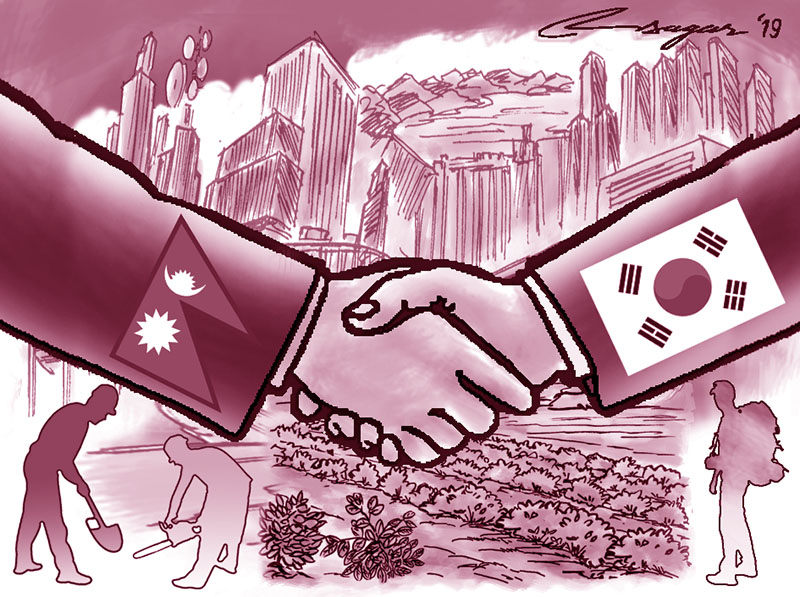Economic diplomacy with RoK: For a prosperous Nepal
Korean demand for certain items, such as yarcha-gumba, Himalayan honey and herbs, Nepali tea and coffee, and Nepali handicraft items, such as pashmina products and hand-woven woollen carpets, can only be supplied from Nepal
Economic diplomacy is an essential part of Nepal’s foreign policy. After the promulgation of the long-awaited constitution, completion of the three-tier elections and formulation of policies, the Federal Democratic Republic of Nepal is now urging global investors to invest here for the country’s economic development. Nepal’s first ever participation in the World Economic Forum (WEF) has promoted Nepal’s desire to attract global investment to achieve sharp and simultaneous economic growth in all sectors. It is hoped that the upcoming International Investment Summit in March 2019 and Visit Nepal Year 2020 would draw more global participation in
Nepal’s economic development to achieve “Prosperous Nepal and Happy Nepali”. In this context, it can be useful to discuss Nepal’s bilateral relationship with one of the top five investors in Nepal, the Republic of Korea (Korea). Having lived there for more than 20 years, my views on the bilateral issues may be supportive in determining how both the countries can benefit.
Korea’s Official Development Assistance (ODA) loan (as low as 0.1% interest per annum for 30 years) received for two hydropower projects is already helping Nepal cope with the present energy situation. In the improved political environment, Nepal can readily bring in ODA from Korea for at least one more hydropower project above 50MW. Extra efforts from the government could bring additional ODA in infrastructure development or the renewable energy sector. Providing ODA helps Korea to fulfill its responsibility as an OECD (Organisation for Economic Cooperation and Development) member country.
Korea is one of the top five investors in Nepal. For increasing the inflow of Foreign Direct Investment (FDI), suggestions from existing foreign investors in Nepal will be very helpful. For investors in the energy sector, for instance, realisation of a proper one window policy that provides all government services, including visa arrangement and repatriation arrangement, through a single desk would be very welcome. The government’s arrangement to support them to hedge the foreign exchange risk in their investment in Nepal will make investment attractive.
Korea Electric Power Company (KEPCO) and its subsidiary companies are working in around 40 projects in 24 countries around the globe. They would be interested to invest in sizable hydropower projects in Nepal, should a Power Development Agreement (PDA) with enhanced investment guarantee be provided. Other Korean conglomerates, such as Hyundai, POSCO, Samsung, Hanwha, are also prominent potential investors in the energy and infrastructure sectors.
Nepal is one of the best tourist destinations in the world. Koreans, in general, have an affinity for hiking, and trekking around the Himalayas is a lifetime dream for many. Korea’s President Moon Jae In had made two personal visits to Nepal before he became the president. Nepal’s unique cultural experience is gaining popularity among young Koreans. For most Korean Buddhists, the Buddha’s birthplace is a must visit destination.
However, the present number of Korean visitors to Nepal is well below the potential. The expensive airfare of the only direct flight connecting Kathmandu with Incheon city is causing diversion of a large number of potential tourists to other destinations in South East Asia. By operating additional inexpensive direct flights between Korean cities and our new airports, significant increase in arrivals can be achieved. Developing low-cost tourism packages and their promotion through the travel agencies, diplomatic mission and Non-Resident Nepalese (NRNs) will help attract more tourists to Nepal. Korean tourists should be able to read promotional materials for Visit Nepal 2020 in the Korean language. Development and promotion of meditation and temple-stay packages for spiritual healing would also boost the number of incoming Korean tourists.
There is a huge demand for natural herbal and organic agricultural products. Korean demand for certain items, such as yarcha-gumba, Himalayan honey and herbs, Nepali tea and coffee, and Nepali handicraft items, such as pashmina products and hand-woven woollen carpets, can only be supplied from Nepal. However, due to lack of information about Korean regulations, export of Nepali agricultural products and handicrafts to Korea is still unexplored. Export of these items to Korea will help Nepal to significantly correct the trade deficit with Korea.
Nepal can learn a lot from Korea as a country with the fastest economic growth. A country with a GDP even less that of Nepal in the 1950s, Korea is today one of the 11 largest economies. Foreign employment in Korea benefits both. Nepali workers contribute to Korea’s economy, and so far, more than 40,000 Nepalis have gone there under the Employment Permit System (EPS). As Nepali workers are considered one of the best labour forces in Korea, Nepal could work with the stakeholders of the EPS to increase the quota for Nepal. Increased quota will provide a higher number of Nepali workers to share Korean experiences and expertise in Nepal.
This way, both countries can harness significant economic benefit through economic cooperation. In addition, a highest level visit between the two countries would further pave the way for “Prosperous Nepal and Happy Nepali”.
Sherpa was a former chief engineer at Hyundai Engineering Company in Korea






